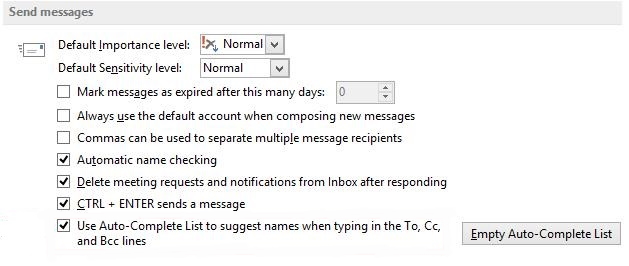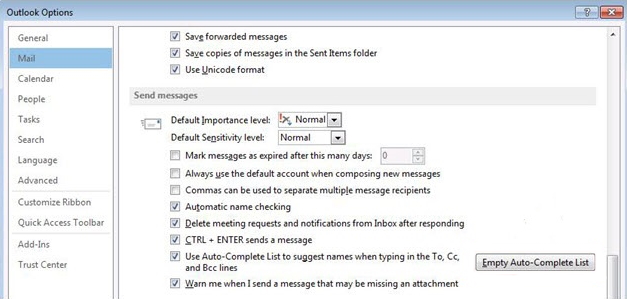The Outlook AutoComplete list
Original KB number: 2199226
Important
Exchange Online provides some search features through Microsoft Search. Beginning in Outlook for Microsoft 365 Version 2202 (Build 14931.20604), if you’re connected to an Exchange Online mailbox, the suggestions list for the To/Cc/Bcc lines when you compose a message is powered by Microsoft Search. In this specific scenario, only two sections of this article apply: “Enable the AutoComplete feature” and “Remove AutoComplete list entries one at a time.”
Microsoft Outlook maintains the AutoComplete list. The list is used by both the automatic name-checking feature and the automatic completion feature. The AutoComplete list, also known as the nickname cache, is generated automatically when you send email messages from Outlook. The list contains SMTP addresses, LegacyExchangeDN entries, and display names for people to whom you have sent mail previously.
Note: The AutoComplete list for Outlook is specific to Outlook and is not shared with Outlook on the web. This app maintains its own AutoComplete list.
Limited number of entries
Outlook limits the number of entries that you can save in the AutoComplete list. After you reach this limit, Outlook uses an internal algorithm to determine the best names to remove from the list. It does this based on the process of usage weighting. Therefore, you might find that some names are unexpectedly removed from your nickname cache. To avoid this situation, you can use the following general approaches:
- You can proactively remove AutoComplete list entries that you no longer need. This is the preferred approach. For information about how to do this, see Remove AutoComplete list entries one at a time.
- You can increase the limit for the nickname cache. Because this configuration is untested, we don't recommend it. If a large nickname cache becomes corrupted, it will be unusable and you could lose many cached entries. For information about how to increase the limit, see Change the limit for the AutoComplete list.
The limits are as follows:
- Outlook 2019: 1,000 entries
- Outlook 2016: 1,000 entries
- Outlook 2013: 1,000 entries
- Outlook 2010: 1,000 entries
Enable the AutoComplete feature
To access the AutoComplete setting, follow these steps:
On the File menu, select Options.
Select the Mail tab.
Scroll approximately halfway down until you see Send messages. Make sure that the Use Auto-Complete List to suggest names when typing in the To, Cc, and Bcc lines box is checked.

Copy the AutoComplete list
Microsoft Office Outlook 2007 and earlier versions store the AutoComplete list in a nickname (.nk2) file on the disk. Outlook 2021, 2019, 2016, 2013, and 2010 store the AutoComplete list as a hidden message in your primary message store. They also let the older .nk2 files be imported.
For the detailed steps to copy the AutoComplete list, and copy and import an .nk2 file, see Import or copy the AutoComplete list to another computer.
Remove AutoComplete list entries one at a time
Follow these steps:
- Open a new email message.
- Type the first few characters of the AutoComplete entry that you want to remove.
- When the entry appears in the list of suggestions, move your mouse pointer over the suggestion until it becomes highlighted, but don't select it.
- When the X icon appears next to the highlighted suggestion, select X to remove the entry from the list, or press the Delete key on the keyboard.
Selecting X will prevent that name entry from appearing in the AutoComplete list again but won't remove it from your account. This entry may still appear in other areas in Outlook (such as search boxes).
Note: If you send a person a new email after you've removed their name from the AutoComplete list, their information will be restored to the list.
Clear the AutoComplete list
Use one of the following two methods to delete the AutoComplete list.
Method 1
Open Outlook.
On the File tab, select Options.
Select the Mail tab.
Under Send Messages, select Empty Auto-Complete List.

Select Yes.
Method 2
Start Outlook by using the /CleanAutoCompleteCache switch.
- Select Start, and then select Run.
- Type Outlook.exe /CleanAutoCompleteCache.
Note: If Outlook is not installed in the default location, you must point to the path of Outlook.exe.
Known issues in the AutoComplete cache
The AutoComplete cache can become corrupted over time and might not save new entries. If this occurs, you can try to remove AutoComplete list entries one at a time. If that doesn't resolve the issue, clear the AutoComplete list."
Change the limit for the AutoComplete list
Because this configuration is untested, we don’t recommend it. If a large nickname cache becomes corrupted, it will be unusable and you could lose many cached entries. Use this information with caution.
Important
This section, method, or task contains steps that tell you how to modify the registry. However, serious problems might occur if you modify the registry incorrectly. Therefore, make sure that you follow these steps carefully. For added protection, back up the registry before you modify it. Then, you can restore the registry if a problem occurs. For more information about how to back up and restore the registry,see How to back up and restore the registry in Windows.
Exit Outlook.
Start Registry Editor.
- In Windows 8.x, press the Windows logo key, type regedit and then press Enter.
- In Windows 7 and Windows Vista, select Start, type regedit in the Start Search box, and then press Enter.
Locate and then select the following registry subkey:
HKEY_CURRENT_USER\Software\Microsoft\Office\<x.0>\Outlook\AutoNameCheckNote: The placeholder <x.0> in this registry subkey represents your version of Microsoft Office. Use the appropriate value from the following list.
- Outlook 2021 = 16.0
- Outlook 2019 = 16.0
- Outlook 2016 = 16.0
- Outlook 2013 = 15.0
- Outlook 2010 = 14.0
On the Edit menu, point to New, and then select DWORD value.
Type MaxNickNames, and then press Enter.
On the Edit menu, select Modify.
Type the new value for the limit, and then select OK.
Note:
- Make sure that you type the number in decimal form. That is the correct form in which to type the number.
- To test the new limit, try to increase the limit by only a small amount. For example, to create a 20 percent increase in the limit in Outlook 2013, you would specify 1200 for the
MaxNickNamesvalue.
Exit Registry Editor.
Start Outlook.
Note:
The MaxNickNames registry value specifies only the nondefault limit. Therefore, you can also use this value to lower the limit of the nickname cache.